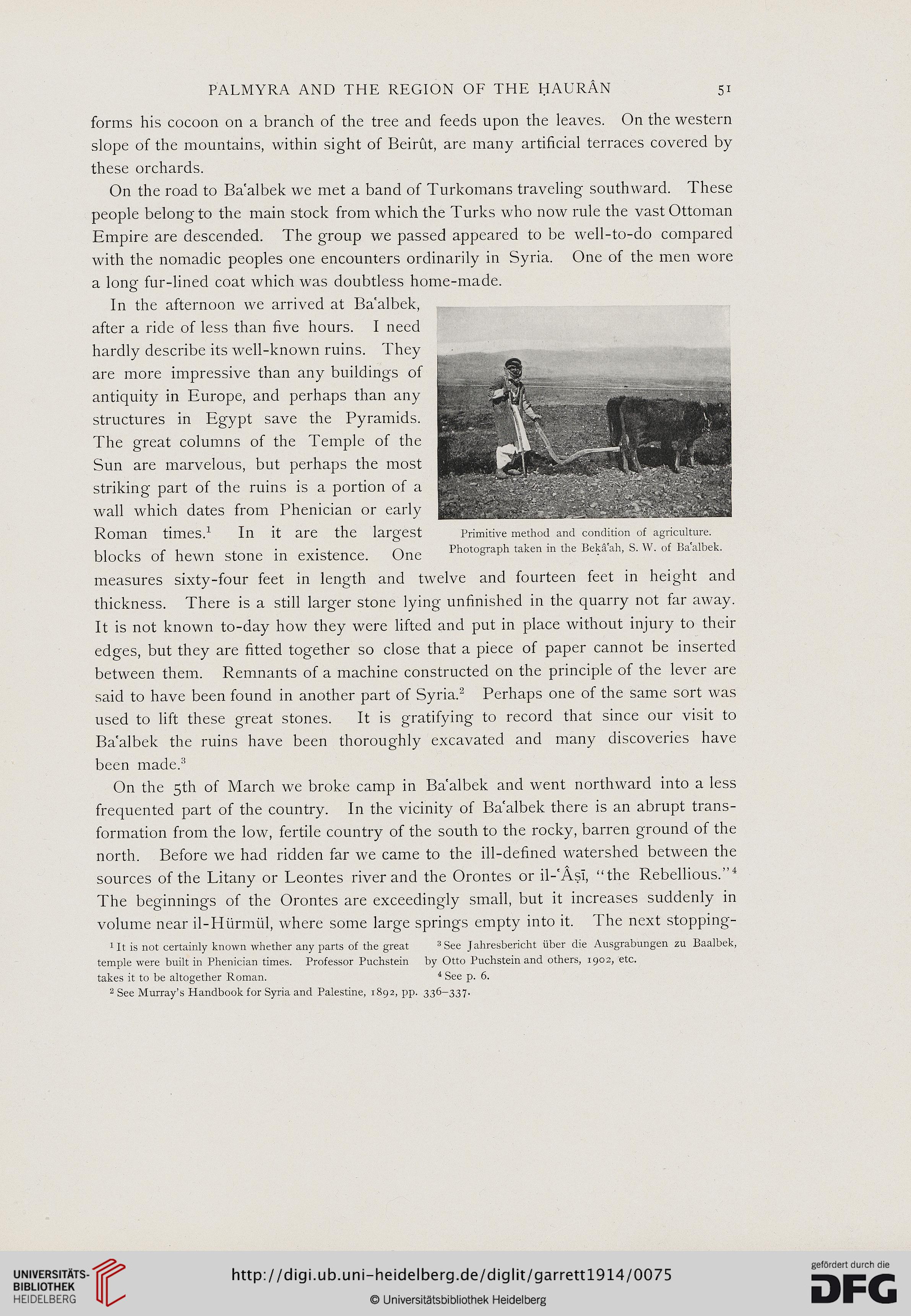PALMYRA AND THE REGION OE THE HAURAN
5i
forms his cocoon on a branch of the tree and feeds upon the leaves. On the western
slope of the mountains, within sight of Beirut, are many artificial terraces covered by
these orchards.
On the road to Baalbek we met a band of Turkomans traveling southward. These
people belong to the main stock from which the Turks who now rule the vast Ottoman
Empire are descended. The group we passed appeared to be well-to-do compared
with the nomadic peoples one encounters ordinarily in Syria. One of the men wore
a long fur-lined coat which was doubtless home-made.
In the afternoon we arrived at Baalbek,
after a ride of less than five hours. I need
hardly describe its well-known ruins. They
are more impressive than any buildings of
antiquity in Europe, and perhaps than any
structures in Egypt save the Pyramids.
The great columns of the Temple of the
Sun are marvelous, but perhaps the most
striking part of the ruins is a portion of a
wall which dates from Phenician or early
Roman timesd In it are the largest
blocks of hewn stone in existence. One
measures sixty-four feet in length and twelve and fourteen feet in height and
thickness. There is a still larger stone lying unfinished in the quarry not far away.
It is not known to-day how they were lifted and put in place without injury to their
edges, but they are fitted together so close that a piece of paper cannot be inserted
between them. Remnants of a machine constructed on the principle of the lever are
said to have been found in another part of Syria. ^ Perhaps one of the same sort was
used to lift these great stones. It is gratifying to record that since our visit to
Ba'albek the ruins have been thoroughly excavated and many discoveries have
been maded
On the 5th of March we broke camp in Baalbek and went northward into a less
frequented part of the country. In the vicinity of Ba albek there is an abrupt trans-
formation from the low, fertile country of the south to the rocky, barren ground of the
north. Before we had ridden far we came to the ill-defined watershed between the
sources of the Litany or Leontes river and the Orontes or il-'Asi, "the Rebellious.
The beginnings of the Orontes are exceedingly small, but it increases suddenly in
volume near il-Htirmul, where some large springs empty into it. The next stopping-
1 It is not certainly known whether any parts of the great 3 See J ahresbericht uber die Ausgrabungen zu Baalbek,
temple were built in Phenician times. Professor Puchstein by Otto Puchsteinand others, 1902, etc.
takes it to be altogether Roman. 4 ggg p g
2 See Murray's Handbook for Syria and Palestine, 1892, pp. 336-337.
Primitive method and condition of agriculture.
Photograph taken in the Bekaah, S. W. of Ba'albek.
5i
forms his cocoon on a branch of the tree and feeds upon the leaves. On the western
slope of the mountains, within sight of Beirut, are many artificial terraces covered by
these orchards.
On the road to Baalbek we met a band of Turkomans traveling southward. These
people belong to the main stock from which the Turks who now rule the vast Ottoman
Empire are descended. The group we passed appeared to be well-to-do compared
with the nomadic peoples one encounters ordinarily in Syria. One of the men wore
a long fur-lined coat which was doubtless home-made.
In the afternoon we arrived at Baalbek,
after a ride of less than five hours. I need
hardly describe its well-known ruins. They
are more impressive than any buildings of
antiquity in Europe, and perhaps than any
structures in Egypt save the Pyramids.
The great columns of the Temple of the
Sun are marvelous, but perhaps the most
striking part of the ruins is a portion of a
wall which dates from Phenician or early
Roman timesd In it are the largest
blocks of hewn stone in existence. One
measures sixty-four feet in length and twelve and fourteen feet in height and
thickness. There is a still larger stone lying unfinished in the quarry not far away.
It is not known to-day how they were lifted and put in place without injury to their
edges, but they are fitted together so close that a piece of paper cannot be inserted
between them. Remnants of a machine constructed on the principle of the lever are
said to have been found in another part of Syria. ^ Perhaps one of the same sort was
used to lift these great stones. It is gratifying to record that since our visit to
Ba'albek the ruins have been thoroughly excavated and many discoveries have
been maded
On the 5th of March we broke camp in Baalbek and went northward into a less
frequented part of the country. In the vicinity of Ba albek there is an abrupt trans-
formation from the low, fertile country of the south to the rocky, barren ground of the
north. Before we had ridden far we came to the ill-defined watershed between the
sources of the Litany or Leontes river and the Orontes or il-'Asi, "the Rebellious.
The beginnings of the Orontes are exceedingly small, but it increases suddenly in
volume near il-Htirmul, where some large springs empty into it. The next stopping-
1 It is not certainly known whether any parts of the great 3 See J ahresbericht uber die Ausgrabungen zu Baalbek,
temple were built in Phenician times. Professor Puchstein by Otto Puchsteinand others, 1902, etc.
takes it to be altogether Roman. 4 ggg p g
2 See Murray's Handbook for Syria and Palestine, 1892, pp. 336-337.
Primitive method and condition of agriculture.
Photograph taken in the Bekaah, S. W. of Ba'albek.




